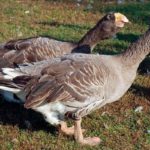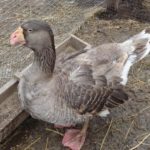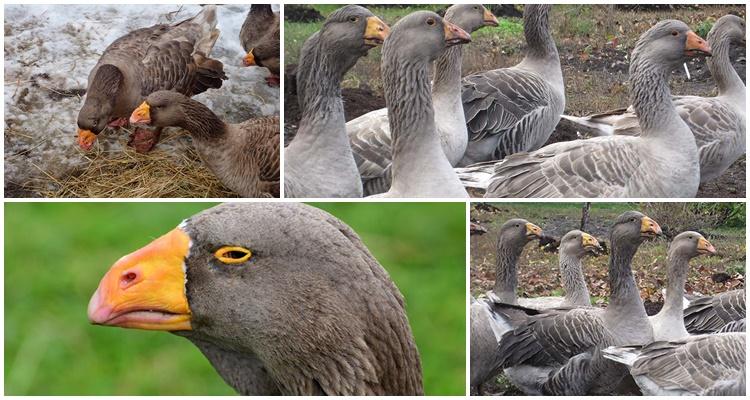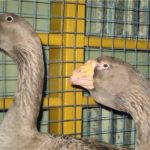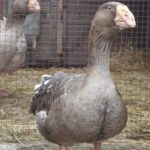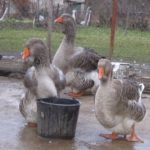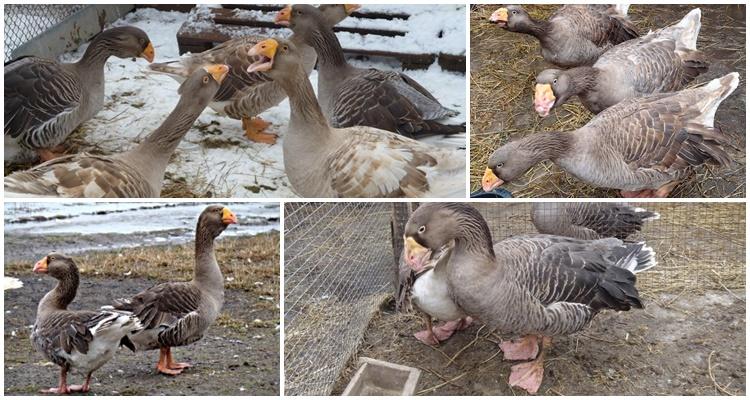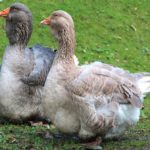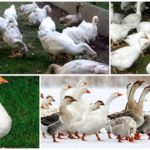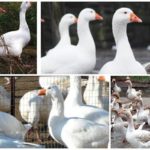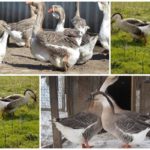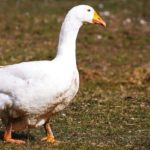Among the variety of goose breeds, the breed of fighting geese stands out. Tula geese were bred with the intention of using ganders for goose fighting. This is the main feature of the variety, but it also has other distinctive characteristics. Let's consider the description of Tula geese, pros and cons, features. And also how to properly raise, feed, maintain and breed poultry.
Description of the breed, its advantages and disadvantages
There is no exact information about who and when the Tula geese were bred.But there is an assumption that the breed was bred in the 17th century for rich people who were fond of goose fighting. The best representatives were selected for several characteristics, the main ones being a large body and pugnacity.
The body of Tula geese is massive, but compact, and the body build is strong. The back and chest are wide and muscular. Short, widely spaced legs, strong wings. Thick short neck. Large head with a short thick beak. The feather is gray or clay-colored, as well as white. Gray birds are similar in color to their wild relatives.
Within the breed there are 3 types, differing in the structure of the beak. In straight-nosed geese, the upper line of the beak is straight, in lodge-nosed geese it is concave, and in steep-nosed geese it is convex.
Characteristics of Tula geese
Since the main characteristics of the breed are fighting, productive qualities are not at a high level. An adult male weighs 5-6.5 kg, with a maximum weight of 8 kg. The goose weighs 5.2-5.5 kg, maximum weight is 7 kg. Egg production of geese – 10-30 pcs. The average egg weight is 180 g. Hump-nosed Tula geese are distinguished by their brooding instinct, so females can be trusted to incubate goslings. Young animals already at 9 weeks of age reach a weight of 3.9 kg.
Due to their pugnacious nature, Tula geese do not get along well with geese of other breeds or with other poultry.
Requirements for maintenance and care
The breed is unpretentious, the birds do not need to organize special housing conditions.They can live in a regular poultry house, but it must be of such an area that there is enough space - at least 0.5 square meters per adult bird. m. The goose barn must be equipped with ventilation and lighting. The length of daylight hours in winter should be at least 10-12 hours.
You definitely need to take care of the bedding in the goose barn. Birds should live on clean, dry bedding. It can be arranged by pouring a layer of sawdust, straw chaff, and dry old peat onto the floor. The thickness should be at least 10-15 cm. In winter, the bedding will warm the geese's paws.
Geese cannot live locked up, so it is impossible to keep them constantly in the house without walking. To organize exercise for birds, you need to arrange a walking area next to the goose barn. You need to drive geese into the pen every day, even in winter, if it is not very cold. Birds can spend the whole day walking. You can also graze on a pond if there is one nearby. Then in the summer you won’t have to feed the geese at all.
Diet
The main food of geese is fresh soft grass, so if you have the opportunity to graze the birds, you can keep them on pasture. If grazing is not possible, you need to mow the grass and feed it to the geese. In addition to greens, feed with mash of finely ground grain, and the grain should be of different types so that the food is complete. Grated root vegetables and vegetables are added to it.
To ensure that fighting geese receive vitamins and minerals, the mash is enriched with premixes and vitamin preparations, fish and meat and bone meal.
Birds need to be fed 2 or 3 times a day, goslings up to a month old - 4-5 times, older ones - 3 times a day. For one adult bird, at least 200-300 g of grain must be given per day.Tula geese are not known for their rapid growth and accumulation of muscle mass, so for commercial rearing for meat you need to select a different breed. But these ordinary, medium-sized geese are well suited for keeping in the household.
Bird breeding
Tula fighting geese hatch their goslings themselves. They lay few eggs, but even from this quantity you can choose material for breeding. Oviposition begins in February; young females begin laying eggs several weeks later.
Up to 12 eggs can be laid under one goose. The females hatch the goslings conscientiously and then carefully raise them. Until the age of one month, Tula goslings live with their mother. At this time, the goose and its offspring must be kept separately from the others so that the goslings are not accidentally trampled. When the chicks are 1.5 months old, the brood can be released into the general flock.
Possible diseases
Despite their strong immunity and cold resistance, Tula geese can suffer from infectious diseases. The bird gets sick if it is kept crowded or if it lives in a dirty, damp, dark room. Prevention of infections is regular cleaning of the poultry house, especially replacing bedding and cleaning feeders and drinkers. Disinfection must be carried out at least 2 times a year.
With improper, irrational feeding, Tula geese are affected by diseases of the digestive tract and metabolism. To prevent them, you need to create a proper, balanced diet. Give wet mash, not dry, plenty of clean water.For hypovitaminosis, add vitamin preparations to the regular food, which can be purchased at veterinary stores.
Description of the fight of geese
This is a fighting breed, which is why goose fights are still held today. According to the rules, birds do not fight to the point of blood, so they are not aggressive and harmless. Geese can only use their wings; you can grab the wing with your beak. You cannot touch the head and paws. Those who break the rules will be disqualified. The battle time is 20-40 minutes, but it ends even earlier if the enemy runs away. During the fight, fighting geese are supported not only by their owners, but also by geese. The strongest fighters are considered to be males who are already 4-6 years old.
Tula fighting geese are an ancient breed that was bred for fighting. But this is not the only purpose. You can keep poultry, like other breeds, for meat. The birds are unpretentious, with careful care they do not get sick, but they also exhibit disadvantages - a pugnacious character and unsatisfactory egg production. However, for those poultry farmers for whom these disadvantages are not critical, the Tula breed will be a good option when it comes to choosing a breed for keeping on a private farm.

